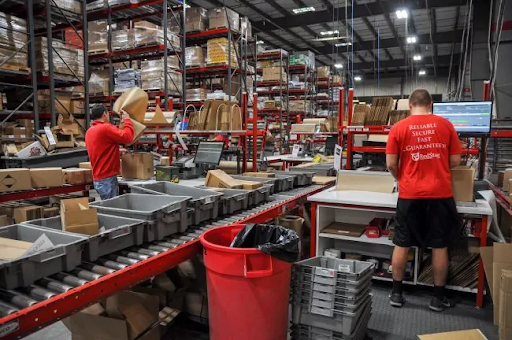Effective order fulfillment plays a central role in e-commerce. When businesses fail to deliver products accurately and promptly, it can lead to customer dissatisfaction and harm the brand reputation. On the flip side, efficient fulfillment fosters customer loyalty, prompting repeat purchases and driving growth. E-commerce entrepreneurs grapple with the decision of in-house vs third-party order fulfillment. This choice isn’t merely logistical; it shapes the customer experience, influences profit margins, and dictates operational flexibility. Each approach has its advantages and drawbacks, placing businesses in a challenging position.
The world of e-commerce is fraught with complexities, and the question of fulfillment stands out. With this article, the aim is to shed light on the intricacies each option and help you decide between in-house vs third-party order fulfillment for your e-commerce business.
In-House Order Fulfillment
In-house order fulfillment means a business manages all aspects of its storage, packing, and shipping processes internally. Typically, the company would maintain a warehouse or storage facility, staff it with employees, and oversee the end-to-end order processing. This hands-on approach ensures that the business has direct involvement in how products reach their customers.
Pros
One of the standout advantages of in-house fulfillment is the unparalleled control it offers businesses. Companies can closely monitor inventory levels, make immediate adjustments, and prevent stockouts or overstock situations.
Another advantage is the direct oversight of the packing and shipping processes. Businesses can ensure that products are packaged securely and presented in a manner consistent with their brand. Such oversight can also lead to quicker problem resolution, such as addressing damaged goods or processing returns.
In-house fulfillment might require a hefty initial investment, but it can also present long-term cost-saving opportunities. When operations are fine-tuned, businesses can cut down on wastage, optimize storage costs, and reduce shipping expenses. Over time, these savings can add up, making the initial outlay worthwhile.
Brands looking to offer a unique unboxing experience or personalized touches will find in-house fulfillment particularly appealing. They can customize packaging, add promotional materials, or even tailor the packing process to individual customer preferences.
Cons
While in-house fulfillment has its advantages, the initial investment can be daunting. Setting up a warehouse, hiring staff, and acquiring necessary technology and equipment demands significant capital. Smaller businesses or startups might find this upfront cost challenging to manage.
One of the pressing challenges with in-house fulfillment is scalability. As businesses grow, they might need larger storage spaces, more staff, and advanced systems to handle increasing order volumes. Additionally, seasonal demand fluctuations can strain resources, potentially leading to fulfillment hiccups.
Operating an in-house fulfillment center requires more than just physical space; it demands continuous resource allocation. Hiring, training, and managing staff, maintaining the facility, and overseeing day-to-day operations can consume a lot of time and energy. E-commerce businesses need to assess their bandwidth for this commitment.
Without adequate expertise, there’s a risk that in-house fulfillment can become inefficient. Mistakes in inventory management, shipping delays, or poor packing practices can harm the customer experience. Thus, businesses must either possess or be willing to acquire the necessary know-how.
Third-Party Order Fulfillment
Third-party order fulfillment, often referred to as 3PL (Third-Party Logistics), involves outsourcing storage, packing, and shipping processes to an external provider. These providers specialize in fulfillment services, utilizing their infrastructure, technology, and expertise to serve multiple e-commerce businesses. Essentially, companies hand over their products to these providers who then handle order processing on their behalf.
Pros
3PLs are designed to handle varying order volumes, making them highly scalable. Whether a business experiences a sudden surge in sales or a slow season, these providers can adjust their operations accordingly. This scalability ensures that e-commerce ventures can grow without constantly rethinking their fulfillment strategy.
3PLs often come equipped with the latest technology and a wealth of logistics expertise. E-commerce businesses can benefit from advanced inventory management systems, tracking solutions, and optimized shipping routes. Coupled with the logistics knowledge these providers bring, it can elevate the overall fulfillment process.
Outsourcing fulfillment can also lead to significant reductions in overhead costs. There’s no need to maintain a warehouse, hire dedicated staff, or invest in technology and equipment. Instead, businesses pay the 3PL provider, often resulting in a more predictable cost structure.
Many 3PL providers have multiple fulfillment centers strategically located across regions or countries. This network can mean quicker shipping times as products are dispatched from the nearest facility. For e-commerce businesses aiming for speedy deliveries, this can be a game-changer.
Cons
One trade-off with 3PLs is the diminished control over the fulfillment process. While providers handle operations efficiently, businesses are a step removed from the nitty-gritty of packing and shipping.
Relying on a 3PL means being dependent on their performance. If they face operational hitches, it can impact the e-commerce business and its customers. Delays, mistakes, or other issues with the provider can potentially harm the brand’s reputation.
Integrating business systems with those of a 3PL can sometimes be challenging. There might be hiccups in syncing inventory levels, processing returns, or communicating special requests. Effective collaboration demands seamless system integration and clear communication.
While 3PLs can reduce overhead, their cost structures can sometimes be unpredictable. Charges might vary based on order volumes, storage needs, or additional services. E-commerce businesses need to be vigilant about understanding the fee breakdown to prevent unforeseen expenses.
Key Factors to Consider
Choosing between in-house vs third-party order fulfillment isn’t a decision to make lightly. Several key factors can sway a business’s choice to ensure alignment with its goals and vision. Let’s go over the pivotal considerations that can shape this decision:
#1: Cost Comparison
Evaluating the financial implications of your fulfillment strategy is crucial. Both immediate and projected expenses play a role in determining which route is more viable for an e-commerce business.
- Fixed vs variable costs: When evaluating fulfillment options, a fundamental consideration is the cost structure. In-house operations often come with fixed costs like rent and salaries, while 3PLs might charge variable fees based on the services used.
- Long-term financial implications: Beyond immediate costs, businesses must also ponder the long-term financial implications of their fulfillment choice. Will in-house operations become more cost-effective over time? Or will the scalability and flexibility of a 3PL save money in the long run? It’s a calculation that involves projecting future business growth and market trends.
#2: Scalability and Flexibility
As your business grows, so will its needs. Assessing the adaptability of a fulfillment method to changing demand and market dynamics is essential to ensure seamless operations.
- Projecting business growth and order volume changes: The ability to scale and adapt to market changes is crucial in e-commerce. In-house fulfillment might limit scalability, whereas a 3PL can adjust more easily to fluctuating order volumes. Businesses need to realistically project their growth trajectory and determine which option best supports this evolution.
- Adaptability to market trends and demand: Adapting to market trends and varying demand is another essential consideration. An in-house operation may struggle to quickly scale up during peak seasons, while a 3PL is designed to handle such variations.
#3: Control and Customization
Your brand’s voice and identity play a significant role in customer retention and satisfaction. Understanding how much control and customization each method offers can determine how well your brand’s essence is conveyed.
- Brand experience in packaging and delivery: Control over the brand experience, especially in packaging and delivery, can be a critical differentiator. With in-house fulfillment, businesses can ensure their brand’s touch in every package. This customization can significantly impact customer satisfaction and loyalty.
- Impact on customer satisfaction: The fulfillment process directly impacts customer satisfaction. Quick, accurate, and nicely packaged deliveries enhance the customer experience. Whether businesses choose in-house or third-party fulfillment, maintaining high standards in these areas is vital.
#4: Expertise and Technology
Leveraging technological advancements and industry expertise can make or break the efficiency of order fulfillment. Businesses must weigh the technological and knowledge benefits offered by each approach.
- Importance of specialized knowledge: Order fulfillment isn’t just about shipping goods; it requires specialized knowledge and expertise. Whether it’s understanding logistics, managing inventory, or navigating shipping regulations, both in-house and third-party options need consideration for their level of expertise.
Benefits of technological solutions: Technological solutions are indispensable for efficient order fulfillment. Advanced inventory systems, automated shipping processes, and data analytics play a crucial role. E-commerce businesses must consider which option allows them better access to these technological advantages.
What Is EcomBalance?

EcomBalance is a monthly bookkeeping service specialized for eCommerce companies selling on Amazon, Shopify, Ebay, Etsy, WooCommerce, & other eCommerce channels.
We take monthly bookkeeping off your plate and deliver you your financial statements by the 15th or 20th of each month.
You’ll have your Profit and Loss Statement, Balance Sheet, and Cash Flow Statement ready for analysis each month so you and your business partners can make better business decisions.
Interested in learning more? Schedule a call with our CEO, Nathan Hirsch.
And here’s some free resources:
- Monthly Finance Meeting Agenda
- 9 Steps to Master Your Ecommerce Bookkeeping Checklist
- The Ultimate Guide on Finding an Ecommerce Virtual Bookkeeping Service
- What Is a Profit and Loss Statement?
- How to Read & Interpret a Cash Flow Statement
- How to Read a Balance Sheet & Truly Understand It
Making the Decision: In-House or Third-Party
When deciding between in-house vs third-party order fulfillment, businesses must assess their current and future needs. Considerations include order volume, financial constraints, growth ambitions, and customer service goals. A thorough assessment helps in making a choice that aligns with both immediate and long-term objectives.
Each business model comes with unique demands and challenges. E-commerce ventures should weigh the pros and cons of both fulfillment methods in the context of their specific operations. What works for one business might not suit another, underscoring the importance of a tailored approach.










